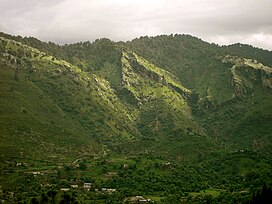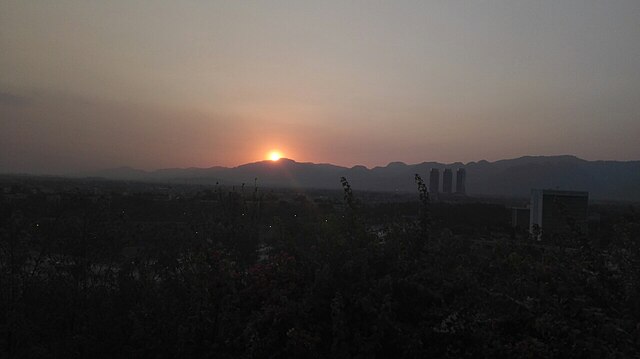Margalla Hills
Himalayan foothills – Islamabad Capital Territory, Pakistan From Wikipedia, the free encyclopedia
The Margalla Hills (Urdu: مارگلہ پہاڑیاں) are a hill range within the Margalla Hills National Park on the northern edge of Islamabad Capital Territory, Pakistan, just south of Haripur District, Khyber Pakhtunkhwa. They are part of the Himalayan foothills. The Margalla range has an area of 12,605 hectares.[1] It is a range with many valleys as well as high mountains.
| Margalla Hills | |
|---|---|
 Margalla Hills | |
| Highest point | |
| Peak | Tilla Charouni |
| Elevation | 1,604 m (5,262 ft) |
| Coordinates | 33°46′33.7506″N 73°7′26.4822″E |
| Naming | |
| Native name | مارگلہ پہاڑیاں |
| Geography | |
| Country | |
| Range coordinates | 33°44′40″N 73°2′30″E |



Infrastructure

Paleontology and archeology
According to the research carried out by scientists and archaeologists of the project "Post-Earthquake Explorations of Human Remains in Margalla Hills", the formation of the Margalla Hills dates to the Miocene epoch. The dominant limestone of the Margalla is mixed with sandstone and occasional minor beds of shale. The archaeologists of the project have also found two human footprints over one million years old here, preserved in sands.
The Shah Allah Ditta Caves are also part of its ancient history. This cave is about 2500 years old and is believed that Alexander The Great as well as several other emperors used this route to either pass by or pass into this area. The cave also have Buddhist-era murals which date at least 2400 years old. The cave has seven alcoves which of different sizes for lamps which are still conserved today. Furthermore, one of the paintings found with the cave was of the Hindu god Shiva.[2]
Flora and fauna

There are around 250 to 300 species of plants on the Margalla Hills. As many as two-thirds of them are used by the people for their medicinal effects to treat or cure various diseases.[3]
The Margalla Hills are home to various species of wildlife, including monkeys, exotic birds and carnivores such as the rare and presently endangered Margalla leopard.[4]
Much less common are leopards, which occasionally come down from the Murree area but usually remain high up in the hills. Villagers dwelling in the Margallas do report sighting of leopards off and on.[5]
Recreation

Bird watching
The Margallas are an excellent place for bird watchers. The area is home to a large number of birds, including robins, sparrows, kites, crows, larks, paradise flycatchers, black partridge, shrikes, pheasants, spotted doves, Egyptian vultures, falcons, hawks, eagles, Himalayan griffon vulture, laggar falcon, peregrine falcon, kestrel, Indian sparrow hawk, white cheeked bulbul, yellow vented bulbul, cheer pheasant, khalij pheasant, golden oriole, collared dove, wheatears and buntings.[4]
The cheer pheasant, indigenous to the Khyber Pakhtunkhwa, was being reared in Margalla Hills as a part of conservation campaign by the World Pheasant Association and Capital Development Authority.[6]
Hiking trails
There are several hiking trails in the Margalla Hills.[7] Trail 3 and 5 are the most popular ones, starting from the Margalla Road opposite sector F-6 and ending at the Pir Sohawa Road.
In total, there are six trails now which are accessible to anyone. Below are the descriptions of each trail:
Trail 1:
This trail is one of the more difficult ones that causes physical exhaustion and it can take up to two hours to finish it. Its highest point is the top of Pir Sohawa, and if you go 20 km ahead on the main road, you will find amazing city views along with the famous Monal Restaurant.
Trail 2:
This trail is not too difficult to climb and is recommended for families and hiking novices. It has many attractions such as street foods, play grounds and tea stalls, hence becoming a good tourist spot. The trail starts behind Islamabad Zoo and ends halfway up to Monal Restaurant.
Trail 3:
As mentioned above, Trail 3 is one of the most popular trails as well as being the oldest. The trail is divided into two parts: 3A and 3B. 3A is the more challenging one with being very steep and rocky and has a rock climbing point, however it is also very short (takes about 40 minutes to cover it). On the other hand, 3B is more easy to walk on as it has wooden and forest covered trek to walk on, but it takes an hour longer to finish than trail 3A. Both sub-trails finish at the same viewpoint.
Trail 4:
Trail 4, situated near the former Islamabad Zoo, runs behind the Jamia Faridia seminary and is frequently utilized by its students. It offers an ideal route for individuals seeking an extended walk deep within the hills, allowing them to fully immerse themselves in the natural beauty of the landscape.
Trail 5:
This is the other "most popular" trail because it is considered an all rounder, as families, runners, walkers and even pets can come here owing to its flat terrain. It goes through beautiful forested area adorned with big rocks and waterfalls. It also has a path leading to Saidpur Village.
Trail 6:
Trail 6 is the latest trail to be added as a hiking trail. Starting from behind the iconic Faisal Mosque's parking lot, it has a steep climb which is less crowded than Trail 3 and 5, making it a good trail for hiking enthusiasts. It takes about two hours to climb it, ending at a waterfall spot through which you can see the views of the city before.[8]
Tourism
Margalla Hills contains several tourist spots that can wow its visitors. One of which is Saidpur Village.
Sitting on the foothills of the Margalla Hills, this village shows how different village and city life can be to both foreigners and locals. This place is a hotpot of religious and cultural beauty that is within Pakistan. It is a place that signifies the religious harmony within the country as there is a mosque, a Hindu Temple and a Church standing side by side. The temple in the village is said to be a small 16th century temple Rama Mandir, which is dedicated to Rama, who has said to be living in this land with his family during their 14 years of exile.
Furthermore, the village also has a Gurdwara, constructed in the 20th century by Sikhs. It contains big rooms that were used at rooms for a school in which the philosophy of Guru Nanak was taught.
Environmental conservation

The ecology of Margallas faces threats from quarrying by stone-crushing plants,[9] deforestation,[10] illegal encroachments,[11] and buildings, and poachers.[12] Crush plants situated around the hills near Taxila are busy eroding the hills for extracting building material.[13] Deforestation is resulting from fires and illegal felling of trees.[14]
Margalla Hills Society
The Margalla Hills Society[15][16] was established in 1989.[17][18]
World Wildlife Fund (WWF) Pakistan
The WWF-Pakistan's 'Green School Programme', in collaboration with the Capital Development Authority (CDA), carries out 'Eco-Adventure Activities' on the Margalla hills to raise awareness in the school children regarding the conservation of natural environment and about the importance of being environmentally responsible.[19]
Events
- On 28 July 2010, Airblue Flight 202 crashed in the Margalla Hills.[20]
- On 6 January 2012, snowfall over Margalla Hills.[21]
- On 11 February 2016, snowfall over Margalla Hills.[22]
Places in Margalla Hills
See also
References
Wikiwand in your browser!
Seamless Wikipedia browsing. On steroids.
Every time you click a link to Wikipedia, Wiktionary or Wikiquote in your browser's search results, it will show the modern Wikiwand interface.
Wikiwand extension is a five stars, simple, with minimum permission required to keep your browsing private, safe and transparent.

